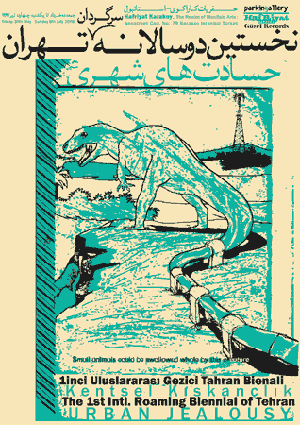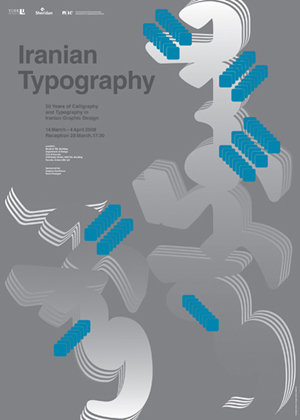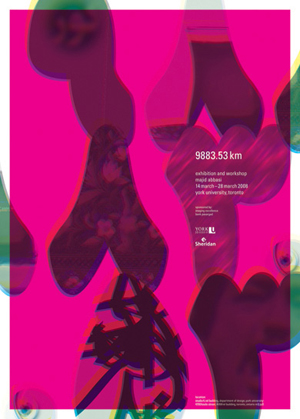Urban Jealousy
the 1st International Roaming Biennial of Tehran
30th May – 6th July 2008
Curated by Serhat Koksal and Amirali Ghasemi
The theme of this biennial is URBAN JEALOUSY. A Jalousie is a window that one can see through but not be seen; barriers that allow us to observe the world without being invited to the table. Iranian artists are given an understanding of what goes on in the world without being offered a single opportunity to communicate their thoughts‹outside of our very own jalousie window: a rigid ethnic frame within an extremely politicized context.
Of all the huge urban areas around the world, Tehran stands out as a different kind of Megalopolis. It boasts one of the most dynamic art scenes in the Middle East even as the city itself deals with a rudimentary public transport system, an exploding population crisis, and an ever-increasing sprawl of mass housing; an unsightly city of experimental architecture that swallows entire villages and towns without offering them any sort of public services.
Source: www.biennialtehran.com
GEN X, Posters by Young Iranian Graphic Designers
March 29 to April 11
4th Floor, TEL Building, York University
This exhibition brings together works from outstanding young talents and marks a great finale to the series of exhibitions held at York University. Presenting 40 posters, a small fraction of current Iranian graphic design scene, this collection offers an exciting landscape of experimental and compelling works that are informed by a rich history of visual culture.
One of the qualities that makes current Iranian graphic design unique is its rich cultural history as demonstrated and displayed in the forms of calligraphy and typography. The three exhibitions at York University encompass 50 years of Iranian visual culture, showcasing over 150 pieces, ranging from iconic works of the first generation of Iranian designers to works by young emerging talents.
Source: www.typography.ir
Iranian Typography in Toronto
March 14 to April 4
Studio 4, 4th Floor, TEL Building, York University
Iranian Typography Exhibition which was originally held last spring at the Basel School of Design (FHNW/HGK) is now going to Toronto’s York University.
The exhibit showcases a diverse collection of work by contemporary Iranian graphic designers that illustrates the depth and breadth of the richness of line, shape, color, harmony, texture and visual rhythm employed by this group of graphic designers.
The richness of Persian culture presents itself in this unique collection of work exposing the treasures of an evolving visual heritage. One of the qualities that makes current Iranian graphic design unique is its rich cultural history as demonstrated and displayed in the forms of calligraphy and typography.
In the introduction of the exhibition’s catalogue Prof. Michael Renner, head of the visual communication institute at the Basel School of design, writes:
We do not have to work hard to find links between the typographic arts of Iran and Switzerland. For example, the typographic work currently being produced in both cultures draws on a rich script-oriented tradition. It is the task of the present generation of designers to reinterpret those traditions in modern form. Of course, neither in Iran nor in Switzerland are they isolated from international influences.
Every design reflects a relationship with its respective tradition as well as with current international developments. Parallels can be discerned in the engagement of Iranian and Swiss designers with digital technology and its influence on visual communication.
Source: www.typography.ir
9883.53km;
An exhibition and workshop by Majid Abbasi in Toronto
March 14-28, 2008;
TEL Building, Room 4023, Department of Design, York University 4700 Keele Street, Toronto, Ontario M3J IP3
Phone: 1 (416) 736 58 85
“9883.53km” showcases a retrospective of book covers and posters designed by Majid Abbasi from 2000 to present. This exhibition illustrates the colorful and engaging design career of a contemporary Iranian graphic designer and typographer.
Majid will hold a workshop at the Department of Visual Communication of York University. The workshop, “Posters for Music”, will be based on the theme of visualizing the musical masterpieces.
Both “9883.53km” and “Iranian Typography, 50 Year of Calligraphy and Typography in Iranian Graphic Design” (which was previously shown at the Basel School of Design FHNW/HGK) will be exhibited at York University beginning March 14th through the 28th of 2008.
A series of lectures will be given by Michael Renner (Head of the Basel School of Design), Gregory Vines (Tutor of the Basel School of Design), Majid Abbasi (Creative Director and Educator), Behrouz Hariri (Student of York University), and Kambiz Shafei (Student of the Basel School of Design).
These lectures will offer a diverse array of perspectives on Iranian graphic design and typography to the audience at the York University, Toronto.
Source: www.typography.ir
Shahnameh
The 5th Color’s 4th Iranian Typography Exhibition 2008
The Shahnameh is the poetic recital of the oldest legendary and mythical Iranian narrations which has been written in verses by Hakim Abol-ghasem Ferdowsi (935–1020).
He spent most of his life writing it, with this work of art he became one of the greatest poets of the world. Ferdowsi’s Shahnameh, in quality as well as in quantity is the greatest classical literary work in the Farsi language; it may even be counted as one of the most important epic works throughout the world. Ferdowsi is a poet for all times, his way of writing in the Shahnameh is simple and clear.
In this collection the generosity and bravery of the well-known Iranian heroes and their astonishing and wonderful stories, their challenges with demons, giants and witches has been written and composed with great beauty. Even today after one thousand years, the Shahnameh as one of the few literary masterpieces of the world with its interpretation opens new doors to the great dimensions of Ferdowsi’s way of thinking.
Source: www.5thcolor.com
Iranian Typography at the Basel School of Design (FHNW/HGK)
Considering the rising interest in Iranian graphic design and Iranian typography, the Basel School of Design will be presenting a series of exhibitions, lectures and workshops from 30th April to 10th May 2007.
The Basel School of Design and its students have influenced the international Graphic Design community since the 1960’s. Under the direction of Armin Hofmann and Emil Ruder courses for Graphic Design and Typography were developed. They were outstanding models for a modernist design education.
The “Iranian Typography” exhibition is a platform for discussion and debate on the particular characteristics of Iranian and Swiss visual cultures.
> Iranian Typography Exhibition
> Posters from Tehran, a selection of Majid Abbasi’s work
> Lectures on Iranian Graphic Design and Typography
> Iranian Typography Workshop
> From Alef to Ye (Swiss Typography Magazine)
> Organization Team
Source: www.typography.ir
THE ORIGINALITY AND GRAPHIC DESIGN TODAY
By Majid Abbasi
The history of art in Iran is divided into two important periods: pre- Islamic and post-Islamic. In the former one, sculpture, engraving, architecture, pottery and varied inscription, all including patterns and images, from the hub of Iranian art. In the later, calligraphy and script appear in the Islamic manuscripts or inscriptions and architecture as a national and celestial art. If we want to study image and type in Iran historically, we should refer to these two important periods. The source and origin of today’s graphic design in Iran go back to the attempts made by past forerunners in this field.
The early samples of graphic designs which can be included in modern framework are related to the 13th century A.H. Since this period we encounter the works which had previously been produced in the west through engravings on wood and copper. These samples are mostly related to book decoration, forms of letters, calligraphy and page decoration and all of them are based on older samples such as lithographic books. The images show parties, war or happiness and these are also based on very old samples of hand-written illustrated books about 400 to 500 years before that.
Modern graphic design looks back at this background and visual-scriptual heritage too. It is influenced by miniature, page decoration and layout of various manuscripts including books of poetry, pieces of calligraphy, illustrated books and their illustrations, and presents a new description of them by means of the rules of today.
But it is not always very fruitful to look at these sources and use them. The conclusion should be based on sufficient knowledge of the past heritage and national originality.
Yet, originality does not have the past values as its only source, it is a concept related to the present time which is rooted in a fruitful past with all its heritage. The surviving heritage which has come down to us completes the meaning of today. This is why the graphic designer tries to be loyal to it.
Graphic design started in Iran seriously, about eighty years ago by the advent of printing machinery and its power to copy works of art.
During the last fifty years there have been attempts made for illustration. Some of these attempts are made by the movement in the modern world of graphic design and some others are made to review the pre- and post- Islamic originality of Iranian arts through today’s techniques and definitions of graphic design.
Modern graphic design started by the attempts of Morteza Momayez (born in 1936); demonstrating some outstanding samples, gradually found a stance for the Iranian view in Iran and international circles. Some colleagues collaborated with him in this way. This generation of designers left one of the most influential samples of Iranian graphic design behind.
The poster of the Ninth Festival of Art, Shiraz designed by Morteza Momayez in 1975 includes ancient Iranian images together with a modern view of graphic design. The use of calligraphy and script in another poster designed by Ghobad Shiva for the Festival of Arts in Shiraz in 1971 was an attempt in the same way and Farshid Mesghali’s illustrations for the book of Iranian modern poetry in 1984 is a retrograde step to the old Iranian illustration which retells a modern story rightly.
It is to be mentioned that the golden age of Iranian modern graphic design started by founding of graphic design subject and educating students in two important universities in Tehran. This period goes back to one decade before 1979 revolution or more which after a nearly ten-year recess has now improved and found its new stance again.
But the new generation of the Iranian graphic designers who basically grew after the revolution and the war, and changed the graphic design in Iran, were the result of their previous generation mentioned before. The audacity and the new ideas of the young graphic designers in using Iranian typography considering the modern technology, their lyricism as well as searching for new concepts with a new image of the Iranian graphic design, are part of what they have done so far. And now they claim a national graphic design with high standards.
A speech in Design Conference in Doha, February 23, 2005 and in the University of Palermo March 22.
Source: www.typography.ir
Quoted
Makin banyak manfaat, makin sedikit dampak, makin baiklah desain itu









